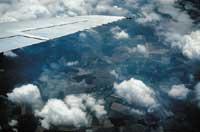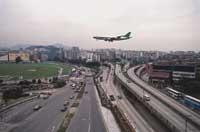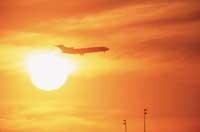Tourist class syndrome
What is the tourist class syndrome?

When traveling by plane, environmental conditions such as temperature, humidity, available space and atmospheric pressure are different from those that are given at ground level. In fact, the most modern aircraft are not usually pressured at sea level, so the pressure in commercial flight is similar to that which is at a height of between 1,500-2,500 meters.
On the other hand, the paralysis of travelers and the relative narrowness of seats can cause a thrombosis of deep veins (SZT), known as "tourist class syndrome". This vascular accident was first described in medical literature in the prestigious journal The Lancet in 1908.
The case of Emma Christofferson, a 28-year-old British girl, who has recently raised enough powders in all newspapers. In October last year he occupied the land at Heathrow Airport in London, after more than 20 hours of flight from Australia. While waiting for his luggage, he suffered a collapse and died.
A thrombus or clot formed in a vein of his legs was released from the wall and reached through the circulation to the lungs, where he was stuck, unable to advance backwards, creating an embolism that caused death. This terrible accident aroused the attention of the media and began to investigate deaths in English hospitals, near Heathrow airport, in circumstances similar to those of this young man. STS (deep vein thrombosis) was found to be more frequent than expected (twelve annual cases have been recorded in some hospitals).
What is deep vein thrombosis?

STS is the formation of thrombus or blood clots in the venous net of our body, especially in the deepest veins of the lower extremities that are found in the lower part of the twins. Often these thrombi can be released from the wall and, following the venous pathway, they can reach the heart or lungs — pulmonary thrombo-embolism — which greatly aggravates the process.
Because the blood that reaches the lower extremities has to resume the ascending path to go back, through the venous net, to the heart and lungs. And that "return" is often prevented by the very force of gravity, for example, if it remains long standing or even sitting. It does not occur when lying or sitting, but with legs up.
So far what we know today. From there things are not so clear. We know that not moving, longer and worse still, can cause STS, but without other tougher tests, it cannot be claimed that traveling by plane poses a higher risk of immobilization than in other modes of transport.
Where is the risk?
According to the report published last May by the prestigious magazine The Lancet, one in 10 passengers on long-haul flights could suffer from thrombosis. The study, led by John São Middlesex and the hospital specialist, provides data on the connection between long-haul flights and codulle formation. According to the researchers, cases of deep vein thrombosis are forty times more frequent after long flights. However, it must be said that most of these blood clots or thrombus are small and, without any effect, dissolve themselves, according to experts.
In any case, this type of circulatory problems affect more people with greater sensitivity for the development of blood diseases, cancer patients, pregnant women, those who have chronic venous insufficiency or are receiving certain hormonal treatments (oral contraceptives, estrogens...), who have recently undergone surgery or polytraumatisms, etc.
Other researchers believe that chronic, obese, diabetic smokers with uncontrolled hypertension or even plaster are people at risk.
What can be done against thrombosis?
In addition to the recommendations of airlines, researchers and experts have made other proposals. Below are two of them.
- A former pilot of the airline British Airways presented in London an invention called Airogym to combat thrombosis that means maintaining the same position during long flights. It is an artiluge like carpet, which the traveler must place under his foot (after removing the shoes, of course), and the movements of contact with this carpet will favor the circulation of the blood to avoid the formation of blood clots.
- On the other hand, three Colombian scientists designed a kind of marker of steps that is applied in the ankles. The device works by electrodes and, by stimulating the circulatory system, prevents the formation or formation of coacids. The inventors were engineer Jorge Reynolds (who had already worked on the markers of the heart and the investigation of the sounds emitted by the whales) and surgeons Jorge Hernando Ulloa Herrera and Jorge Ulloa Domínguez.
 Airlines seek resources to combat tourist class syndrome.
Airlines seek resources to combat tourist class syndrome.
However, I have not made long or short flights for a long time. Therefore, dear reader, if you tell us your experience, we would be delighted to read your comments. A greeting and enjoy the chosen flight!
Most lines of air knew about the syndromeAs was demonstrated in the study carried out by the documentary program Panorama of the BBC television network, the airlines had been trying for more than 10 years to hide the problem: the possible connection between the long journey they knew and the appearance of thrombosis in depth. However, according to Panorama, they rejected the requests of scientists to study the formation of thrombi in travelers or, what is worse, they rejected this type of research. In 1996, when the expert San Shuster requested the British Airways airline permission to conduct a study among its passengers, the company refused because, according to his words, "most travelers only want to travel in peace." And they said unto him, "As a commercial organization, we have no intention of authorizing anything that can suggest that flights can be negative for health." |
Recommendations of the airlinesFor example, the recommendations designed by the US Aerospace Medical Association. and that assumes Iberia are:
If you have any of these risk factors, you should consult your doctor to check if you are able to make a long flight. Iberia proposes the following exercises in the seats:
And finally, the sixteen largest airlines in the world pledged in March 2001 to collaborate with WHO (World Health Organization) in the resolution of the causes and cases of this syndrome. And some of them have since launched quite curious proposals. To increase passenger comfort, the German airline Lufthansa, for example, has planned to build a 'fitness cabin' on its aircraft. But, for the moment, they will only be for first class passengers. Where are the tourist class travellers left? |





